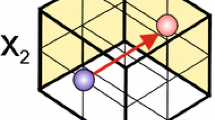Abstract
The total electric field gradient (EFG) tensor V pq is calculated by numerical integration of threedimensional integrals. Each of them is solved a) by integrating over one dimension analytically and b) by integrating over the remaining two dimensions on the basis of a Gauss-type integration rule. The use of 100 abscissas in the twodimensional numerical integration scheme yields satisfactory accuracy which was checked by evaluating overlap integrals; an increase to 400 abscissas does not increase the result drastically. Calculating quadrupole splittings ΔE Q from numerically integrated electric field gradient tensors V pq we observe that depending a) on the amount of covalency and b) on the amount of deviation from octahedral or tetrahedral symmetry, involved in a molecular system, overlap and ligand contributions to V pq play an important role. Especially for the sandwich compound ferrocene, Fe(C5H5)2, we find a significant difference between ΔE num. int.Q which follows from the numerical integration method, and ΔE conventionalQ which is derived from effective charges.
Similar content being viewed by others
References
Ingalls, R.: Phys. Rev. 128, 1155 (1962)
Trautwein, A., Harris, F. E., Dezsi, I.: Theoret. Chim. Acta (Berl.) 35, 231 (1974)
Trautwein, A., Reschke, R., Dezsi, I., Harris, F. E.: J. de Phys. 37, C6, 463 (1976)
Sternheimer, R. M.: Phys. Rev. 80, 102 (1950); Phys. Rev. 84, 244 (1951); Phys. Rev. 95, 736 (1954); Phys. Rev. 105, 158 (1957)
Pople, J. A., Beveridge, D. L.: Approximate molecular orbital theory. New York: McGraw-Hill 1970
Rein, R., Clarke, G. A., Harris, F. E.: Quantum aspects of heterocyclic compounds in chemistry and biochemistry II. Israel Academy of Sciences and Humanities 1970
Löwdin, P. O.: Phys. Rev. 97, 1474 (1955)
Foley, H. M., Sternheimer, R. M., Tycko, D.: Phys. Rev. 93, 734 (1954)
Edmonds, A. R.: Drehimpulse in der Quantenmechanik. Mannheim, Wien, Zürich: Bibliographisches Institut
Harris, F. E.: Computational methods of quantum chemistry. TXVII prepared for the 1967 Summer Institute in Quantum Chemistry, Solid State Physics and Quantum Biology, Uppsala, Sweden
Trautwein, A., Harris, F. E.: Theoret. Chim. Acta (Berl.) 30, 45 (1973)
Fraga, S., Karwowski, J.: Tables of Hartree-Fock atomic data. University of Alberta, Edmonton, Canada T6G2G2
Moore, C. E.: Atomic energy levels. Cur. Nat. Bur. Std. (1949)
Zimmermann, R., Trautwein, A., Harris, F. E.: Phys. Rev. B12, 3902 (1975)
Trautwein, A., Kreber, E., Gonser, U., Harris, F. E.: J. Phys. Chem. Solids 36, 325 (1975)
Reschke, R., Trautwein, A., Desclaux, J. P.: J. Phys. Chem. Solids 38, 837 (1977)
Trautwein, A., Reschke, R., Zimmermann, R., Dézsi, I., Harris, F. E.: J. de Phys. 35, C6, 235 (1974)
Ingalls, R. I.: Phys. Rev. 133, A787 (1964)
Johnson, C. E.: Proc. Phys. Soc. (London) 92, 748 (1967)
Zurmühl, R.: Praktische Mathematik. Berlin, Heidelberg, New York: Springer Verlag 1965
Davis, Ph. J., Rabinowitz, Ph.: Methods of numerical integration. New York: Academic Press 1975
Author information
Authors and Affiliations
Additional information
Supported by Deutsche Forschungsgemeinschaft
Rights and permissions
About this article
Cite this article
Reschke, R., Trautwein, A. Numerical integration of overlap and ligand contributions to the electric field gradient. Theoret. Chim. Acta 47, 85–96 (1978). https://doi.org/10.1007/BF00547746
Received:
Issue Date:
DOI: https://doi.org/10.1007/BF00547746




